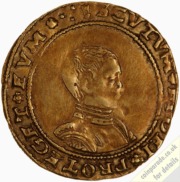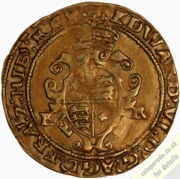 The 1549-1550 Gold Half-Sovereign, Second Period - Edward VI
The 1549-1550 Gold Half-Sovereign, Second Period - Edward VIGold Half-Sovereign issued in the reign of King Edward VI around 1549-1550. Second Period (Jan 1549-Apr 1550). SCBC 2435. North: 1908. Mint mark: arrow. Diameter 29mm and weighs 5.465g. Half-Sovereigns are worth 10 shillings.
Gold coins of Edward VI can have many variations, and they are expensive (starting at thousands of pounds going on to tens of thousands and even more).
The Obverse shows the bare head bust of the young King, wearing armour, facing right. Mint mark arrow then legend around is "SCVTVM FIDIE PROTEGET EVM", meaning 'The shield of faith shall protect him'. Inner circle of beads.
 The Reverse shows a crowned, ornate oval, containing a quartered Royal shield. 'E R' divided across. Mint mark arrow then legend is "EDWARD VI D G AGL FRA Z HIB REX +". Inner circle of beads.
The Reverse shows a crowned, ornate oval, containing a quartered Royal shield. 'E R' divided across. Mint mark arrow then legend is "EDWARD VI D G AGL FRA Z HIB REX +". Inner circle of beads.Image credit: Museums Victoria
Mintage: Not known
Minted at The Royal Mint
Below are some coins currently being offered on eBay. As an eBay Partner, We may be compensated if you make a purchase.
 Edward VI of England was born on 12 October 1537, the son of Henry VIII and Jane Seymour. He became King of England and Ireland in 1547 aged only 9 years old, having a Coronation on 20 February 1547. He was in the house of Tudor. Due to his young age, the realm was governed by a regency council led by his uncle Edward Seymour and then by John Dudley.
Edward VI of England was born on 12 October 1537, the son of Henry VIII and Jane Seymour. He became King of England and Ireland in 1547 aged only 9 years old, having a Coronation on 20 February 1547. He was in the house of Tudor. Due to his young age, the realm was governed by a regency council led by his uncle Edward Seymour and then by John Dudley.Edward died on 6 July 1553 (just 15 years old) after a serious illness and was buried in Westminster Abbey. Edward had decided that his first cousin once removed, the 16-year-old Lady Jane Grey, should become Queen. However, after his death his half-sisters Mary and Elizabeth desputed the succession and after only nine days Jane was removed from the throne (and subsequently executed) and Mary became Queen of England and Ireland.
The first coins issued in the reign of King Edward VI were in the name and some with the image of his father King Henry VIII. Later coins show the image of the boy King. There were still troubles with the debasement of gold and silver introduced by Henry VIII. There are many variations, some very nice coins but can be very expensive (up to six figures). Several Mints around the country were used.
The Half-Sovereign wa introduced a long time ago, in 1544 during the reign of Henry VII. However it was discontinued in 1604 (along with full sovereigns) and no more were minted until 1817. Production ended again in 1926 (1933 in Australia) and except for a few special issues during the Coronation years, it was 1980 when we saw half-sovereigns again.
As the value is half of one sovereign, that gives the half-sovereign a face value of half a pound or ten shillings - 50p in post-decimal money, although you're going to have to pay somewhat over the gold price if you want to buy one.
The Obverse is the Monarch's head (Edward VI) and on modern half-sovereigns the Reverse is most often St George and the Dragon (usually the Benedetto Pistrucci version), although other backs have been used.
Specifications for 1549-1550 Gold Half-Sovereign, Second Period - Edward VI
- Weight: 3.99 g
- Diameter: 19.30 mm
- Thickness: 0.99 mm
- Purity: 22 carat = 91.67% (11/12ths gold, 1/12th copper. Adding copper makes the coin more scratch and dent resistant)
- Gold Content: 3.6575 g = 0.1176 troy ounce
- Face value: £0.50 = 10 shillings (decimal: 50 pence)
- Monarch: Edward VI
- These specifications apply to half-sovereigns from 1817.
History
Up until 1604 there was a coin called the English gold sovereign and in 1816 when there was the "Great Recoinage" the name was revived. At that time standard gold (22 carat) was valued at £46 14s 6d per troy pound; this meant a £1 coin needed to weigh 123.2744783 grains or 7.988030269 g. The weight is still the same today.
As a historical note: to maintain the Gold Standard, in 1816 the value of silver was set at 66 shillings for one troy pound and silver coins were only legal for denominations up to £2. The diameter of a half-sovereign is 19.3mm and is only slightly smaller than a full sovereign (22.05mm) so first appearance may confuse inexperienced buyers. You can see in the image on the right, the half-sovereign on the right hand side is quite similar to the full sovereign on the left.
The diameter of a half-sovereign is 19.3mm and is only slightly smaller than a full sovereign (22.05mm) so first appearance may confuse inexperienced buyers. You can see in the image on the right, the half-sovereign on the right hand side is quite similar to the full sovereign on the left.
While you can buy half-sovereigns, many collectors only own them as part of a set.
Formed in the reign of Alfred the Great about the year 886, during the period 1279-1812 it was generally referred to as The Tower Mint as it was housed at the Tower of London. The Master of The Royal Mint has included famous figures such as Sir Isaac Newton.
Since 2010 it has operated as Royal Mint Ltd, a company owned by HM Treasury, under an exclusive contract to supply all coinage for the UK although it also produces medals and coins for other countries. It is currently located at Llantrisant, Wales.
The orignal coinage was Pounds, Shillings and Pence but since decimalisation on 15 February 1971, it is £1 = 100p, that is One Pound = 100 pence. The coinage of the UK is also a long history, the Royal Mint being established as long ago as 886AD when coins were hammered. Today there is perhaps 30 billion coins in circulation, and many (numismatic) collectors coins and sets are issued frequently in gold, silver and other metals.
As an eBay Partner, We may be compensated if you make a purchase.







